An Old Testament KnoWhy[1]
Gospel Doctrine Lesson 13: Bondage, Passover, and Exodus
(Exodus 1-3; 5-6; 11-14) (JBOTL13A)
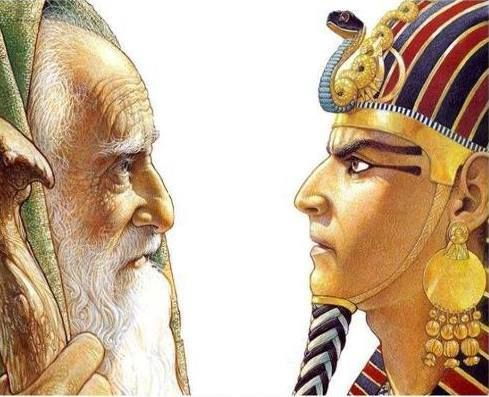
Figure 1. Moses and Pharaoh
Question: What did the Lord mean when He said Moses would become “god to Pharaoh”?[2] And how did the symbolism of the plagues undermine the worship of the Egyptian gods?
Summary: Surprisingly, Exodus 7:1 does not say that Moses was to be “like a god” to Pharaoh. Rather, the Lord’s words to the prophet in Hebrew read literally: “I have made you God/god to Pharaoh.”[3] To make sense of this statement, it must be remembered that Pharaoh was considered to be a god by his people, “the living embodiment of the god Horus, god of kingship, represented by the falcon.”[4] Thus, to prepare Moses for his summit meeting with the leader of Egypt, the Lord made him not only Pharaoh’s “equal” in rank but in addition also enabled him to demonstrate the greater potency of the true and living God whom he served. Because Pharaoh was divine in the eyes of the Egyptians, “he should have been the one to function as a god to Moses.”[5] However, in a display of power whose symbolism would have been understood both by the Egyptians and the people of Moses, Jehovah, the God of Israel, turned the tables against Ra, the supreme sun-god of Pharaoh. By means of the plagues, the great I AM executed His judgment “against all the gods of Egypt,”[6] a phrase meant to include Pharaoh and his firstborn son. Drawing primarily on the work of Rutgers professor Gary A. Rendsburg,[7] this article will describe the significance of the means by which Jehovah devastated Ra.
The Know
Moses as Pharaoh’s Equal (or Better)

Figure 2. Reed Basket
Moses as Horus, Pharaoh as Seth. Many Bible scholars have discussed parallels in the birth story of Moses in the Bible and that of Sargon of Akkad given in Mesopotamian legend.[8] However, Gary Rendsburg observed that since Moses’ birth story is set in Egypt a better analogue might be found in Egypt itself.[9] Indeed, one exists within the well-known traditions concerning Isis and Osiris.[10] Within these traditions we are told of how the Egyptian god “Horus,[11] the son of [the goddess] Isis, was hidden by his mother in a papyrus basket among the marshes to protect him from his wicked uncle Seth.”[12]
Arguing further for the superiority of parallels for the birth story of Moses in Egyptian rather than Mesopotamian sources, Gary Rendsburg notes that in non-Egyptian examples of the “exposed-infant motif” “the goal is for the parents to be rid of the child that is exposed to nature.”[13] However, by way of contrast, both Jochebed,[14] Moses’ mother, and Isis, Horus’ mother, are trying to protect the child. And who is the source of the danger? In the story of Moses it is Pharaoh, and in the legend of Horus it is the wicked Seth.
Thus, in a single narrative stroke, Exodus both likens Moses to young Horus, “the latter a mythic equal of the living Pharaoh,” and, in a personal affront to the divinity of the Egyptian leader, also makes Pharaoh akin to Seth, a personification of evil and chaos in the Egyptian religion.[15]

Figure 3. Moses and Aaron Before Promotion (after Rendsburg)

Figure 4. The Promotion of Moses and Aaron (after Rendsburg)
The promotions of Moses and Aaron. In discussing the Lord’s statement to Moses that he will be elevated to assume the role of “god to Pharaoh,”[16] Rendsburg observes that “Aaron receives a [corresponding] promotion from his normal rank of priest[17] to that of prophet [“mouth”[18] or “spokesman”[19]]. Which is to say, each of the two leading figures in the narrative is advanced in rank for the purpose of this crucial meeting with Pharaoh.”[20] Figures 3 and 4 summarize Rendsburg’s understanding of how Moses and Aaron newly assumed these offices.

Figure 5. The Promotion of Moses and Aaron Clarified
However, in light of Joseph Smith’s teachings, Rendsburg’s figure can be improved. In a discourse given on 23 July 1843, the Prophet briefly taught about the offices of prophet, priest, and king in the Melchizedek priesthood. He explained that individuals could “advance from prophet to priest and then to king, not to the kingdoms of this earth but [rather to the kingdoms] of the most high God.”[21] Joseph Smith said this in order to clear up public misunderstanding of an enigmatic statement he had made the previous week that Hyrum was henceforth to “be the prophet.” His close associates in the audience would have comprehended what the Prophet had been trying to say: namely, that while not renouncing his own role as a prophet, he was, in addition, soon to receive the fulness of the Melchizedek priesthood,[22] by which he would be made a priest and a king unto God.[23] Significantly, D&C 76:56-58 equates being made a priest and king in this sense with becoming a god or a son of God.[24] Thus, the joint advancement of Joseph and Hyrum serves as a fitting confirmation and analogue to that of Moses and Aaron. Figure 5 clarifies the promotion of Moses and Aaron by distinguishing between the office of priest in the lesser (Aaronic) and that of priest and king in the greater (Melchizedek) priesthoods.
The idea that kings and others, such as Moses, could become gods and sons of God through ritual was once widespread, not only in Israel but throughout the ancient Near East. In addition, Revelation 1:6 and 5:10 make it clear that becoming kings and priests unto God was something that all faithful Christians could eventually expect. For more on this topic as it relates to Moses, see the Appendix to this article.
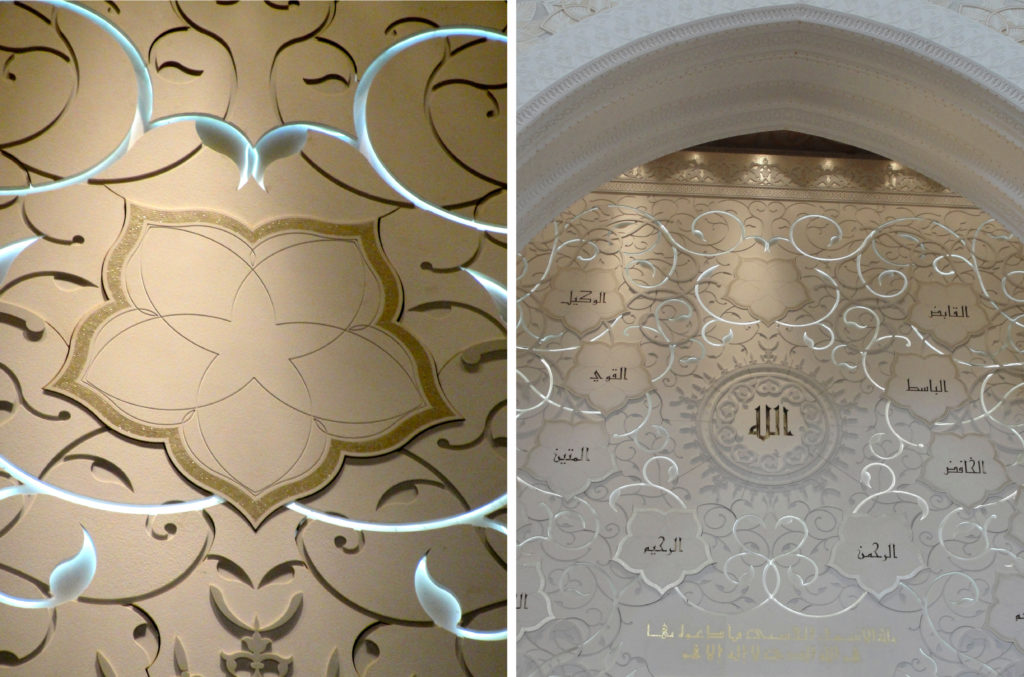
Figures 6a, b. Names of Allah on Wall of Abu Dhabi Mosque. The plaque with no name at top center represents the unknown name of Allah that will be given to the faithful after death. Photograph by Jeffrey M. Bradshaw
Moses as possessor of the unknown name of God. Throughout the ancient Near East (and elsewhere), deities often have an “unknown” name, revealed only to a select few in speciic circumstances.[25] The possession of the divine name is evidence that the recipient has spoken with God Himself, face to face.
Thus, when Moses meets with Jehovah at the site of the “burning bush” (representing God’s glorious appearance in the midst of the tree of life[26]), the second of the four objections he makes to his calling is that he will be unable to answer when the children of Israel ask him if he possesses God’s name as a proof of his divine commission. “God responds not with any of the standard divine names used in the Bible — [Jehovah, Elohim, Shaddai], etc. — but rather proclaims … ‘I am that I am.’ This unique divine name is to be understood [in the context of the story of Exodus] as the ‘unknown’ name of [Jehovah]”[27]
Like Jehovah, the supreme sun-god Ra has an “unknown” name. For example, one Egyptian myth tells of how Ra refused to give his name to Isis. In her determination to learn it, Isis creates a snake to bite Ra. Ra suffers terribly and, eventually, to persuade Isis to heal him, he is forced to reveal it.[28] Why does Ra resist so firmly the disclosure of his name? By his own declaration in the story, he dreads the powerful magicians who might make use of his name in their spells. For this reason, even in the myth itself, the name is not given — the reader is told simply that Isis learned the name.[29]
In contrast to the seeming vulnerability of Ra to the magicians, Exodus portrays Jehovah as having no fear of being subject to the power of anyone who might learn his name. Thus, God reveals it straightforwardly when the worthy and prepared Moses asks for it, and even allows readers of Exodus to learn it for themselves.[30] (Of course, the name revealed in scripture is not actually the “unknown” name of Jehovah. However, by including this story in the book of Exodus, readers are enabled to grasp the important concept being taught.)
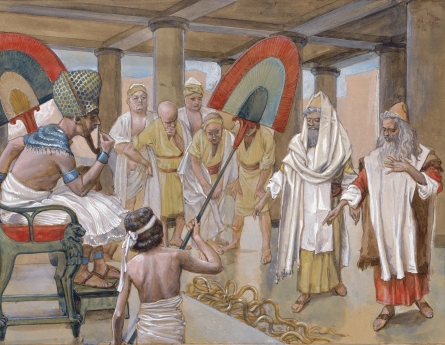
Figure 7. Jacques Joseph Tissot (1836-1902): The Rod of Aaron Devours the Other Rods
Moses bests the magicians. Moses’ third objection to his calling is that the people will not believe that God sent him. “So, how best to impress people in Egypt with one’s power, to instill belief in them? The answer: to empower the hero with the ability … associated with the [Egyptian] lector-priest. Accordingly, God instructs Moses at this point to cast down his shepherd’s staff, which turns into a snake …, and then, upon Moses’ grasping the snake by the tail, it reverts to a staff.”[31]
In looking for priestly analogues to the biblical story of the staff that is transformed to a serpent, Scott Noegel references the Egyptian priestly ritual of casting down wax figurines of Apep, the primordial serpent of chaos. … In the Egyptian context, the rite served to maintain the cosmic order by assisting the sun god [Ra] on his journey through the underworld.”[32] “The biblical account appears to represent a literary inversion of the Egyptian priestly ritual. …[D]epicting Aaron’s serpent as devouring [the others] would signal a threat to the Egyptian cosmic order, a warning realized the next morning with the first plague.”[33]
A similar maneuver to the casting down of the staff is performed by the chief lector-priest Webaoner and his caretaker in the Egyptian tale of “The Wax Crocodile.”[34] In this story, Webaoner creates a crocodile of wax “seven fingers long,” and instructs his caretaker to cast it into a lake when his adversary comes to bathe. Doing so, the wax crocodile becomes a live crocodile of “seven cubits” and swallows his enemy. Later, when the king visits, Webaoner catches hold of the real crocodile and it again becomes a wax crocodile in his hand. Although the story does not say explicitly that the crocodile is caught by the tail, images of magician-priests holding crocodiles by the tail have been found on Egyptian seals.[35]
But what does a crocodile have to do with a serpent? Significantly, although Moses’ staff becomes a serpent when it is cast down in the desert, in Pharaoh’s presence it is transformed instead into something described in Hebrew as a tannin.[36] This difference in terminology is obscured by the King James Version, which renders the two different Hebrew nouns with the same English word “serpent.” Significantly, Rendsburg takes the meaning of tannin to be “crocodile,” corresponding both to the story of the wax crocodile and the Egyptian figure of chaos.[37]
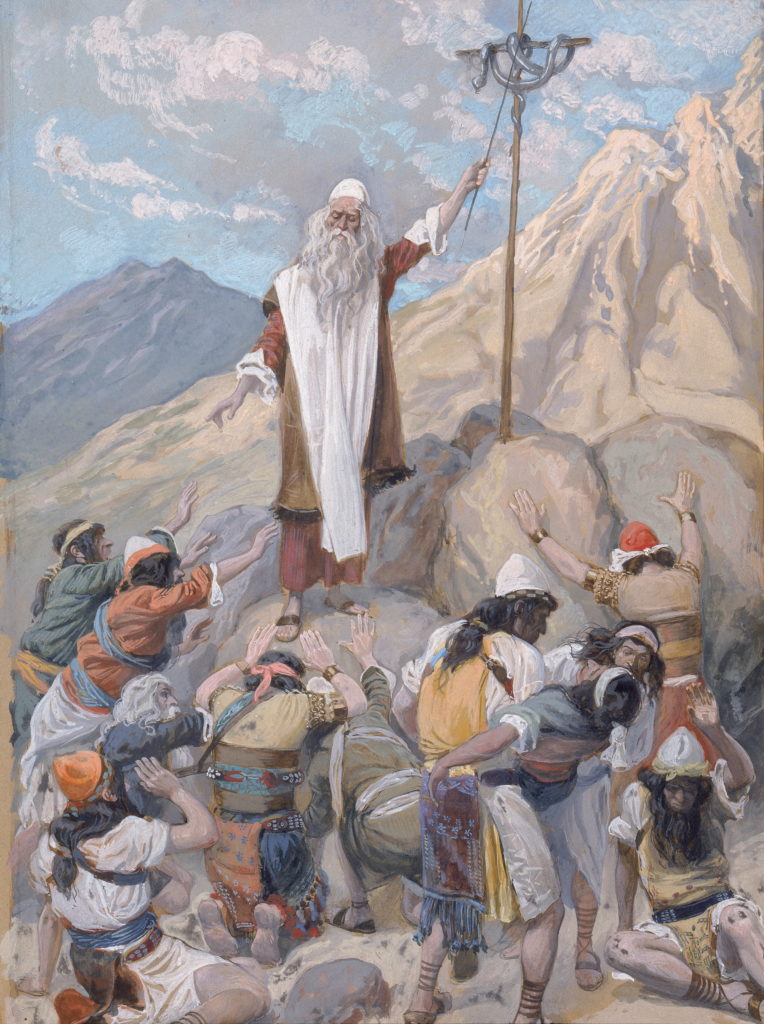
Figure 8. Jacques Joseph Tissot (1836-1902): The Brazen Serpent
Leaving Egypt and returning to the desert, the snake symbolism once again becomes appropriate to the situation. In Numbers 21:6-9, Moses puts a serpent upon a pole, here representing the true God to which Israel should look and live.[38] The “superpositioning” of the serpent atop the pole may relate to royal iconographic materials in Egypt described by Noegel, where the item placed on top is a symbol of dominance and control.[39]
Were Moses and Aaron performing magic? Noegel answers this question as follows:[40]
[T]he magicians’ use of “spells”[41] is contrary to Moses and Aaron’s method, “which is unaccompanied by [any incantations].” [However,] this does not rule out the possibility that Moses and Aaron’s acts may have been perceived as magic by the Egyptians, especially the magicians who were steeped in magical lore. … Thus, while literarily the stories in Exodus conveyed to the Israelites a theological polemic in [Jehovah’s] defeat over Egyptian magic and belief, they were also not without meaning for the Egyptians, who perceived in [Jehovah’s] wonders a significance within the context of their own belief system.
The redactor of Exodus must have also presumed that prominent Egyptian traditions and priestly arts would have been recognized by at least some of his readers, or it would have made no sense for him to have included them in the account in the first place.
The Plagues Through the Lens of Egyptian Tradition
Scholars have looked at the Exodus account of the ten plagues from multiple perspectives. From a literary point of view, “the nine plagues of Exodus [in their current form] constitute a literary unity comprised of three parallel cycles, with the tenth plague functioning as the climax.”[43] In scripture, the number ten often reflects completeness.[44]

Figure 9. Algae blooms offer one explanation of the waters turning to blood.
Photograph by Adam Fritzler[42]
Some have tried to explain the plagues as natural phenomena,[45] the first six disasters forming “a progression of events, each of which naturally resulted from one of the plagues before it” and the next three plagues fitting “with the general pattern of the Egyptian agricultural and seasonable calendars. The last plague [of the death of the firstborn], of course, does not correspond to any natural phenomenon.”[46] Though the idea of framing the plagues in terms of natural events may have some merit, Wells concludes that there is “little in the plagues stories themselves to move the reader in that direction. Ultimately, the plagues are symbolic of chaos, and they overthrow the right ordering of life so prized by the Egyptians.”[47]
Below we will explore the plagues one by one as they might have been seen through the lens of Egyptian tradition. Each of the plagues except 5 and 7 have been previously discussed by Rendsburg and many others.
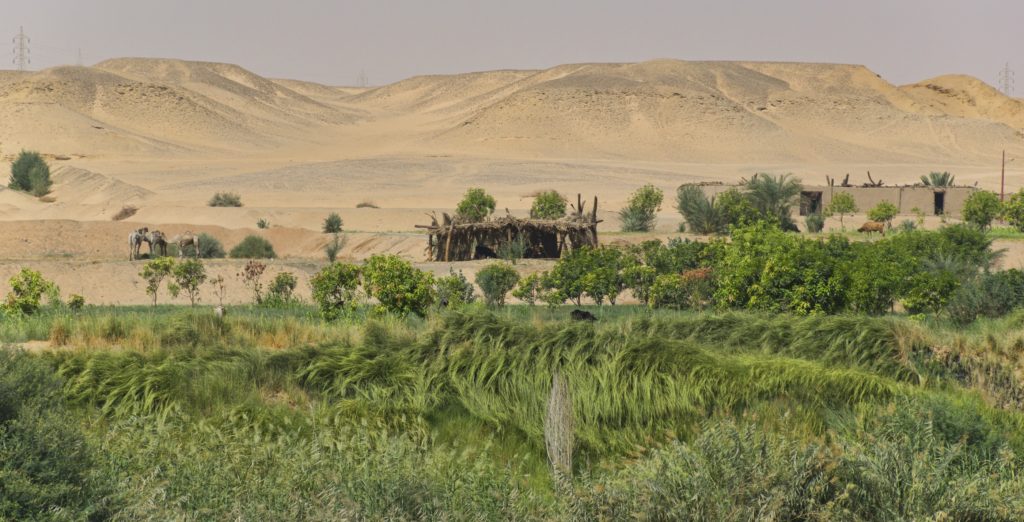
Figure 10. Greenery along the banks of the Nile with desert beyond.
Photograph by Stephen T. Whitlock
Plague 1: Turning the Nile into blood. The first plague is a perfect example of how the overthrow of order was symbolized in the plagues. Not only was the water of the Nile the literal “lifeblood” of Egypt’s prosperity, but in addition the change in color had terrifying religious implications. The word “blood” in Egyptian also means “red,” and in “Egyptian ritual pracice, red [was] the color of Apep, the serpent of chaos, and it serve[d] as a synonym for ‘evil.'”[48] “The annual flooding of the Nile was … associated with the resurrection of Osiris. Thus, the bloodlike waters might signal his death rather than his resuscitation, death for Egypt’s agriculture rather than verdant fields, a frightful prospect for the Egyptians.”[49]
A precedent for the plague appears in the Egyptian tale of Ipuwer. The tale laments that “the river is blood, yet one drinks from it. Men … thirst after water. … Indeed the desert is throughout the land, the [territories of Egypt] are laid waste. Foreign tribes[50] come into Egypt. They are really no people.”[51] Noegel observes: “As in the biblical text, the Egyptian story describes a bloody Nile and a defeat at the hand of foreigners.”[52]
Plague 2: Frogs. Rendsburg comments: “There is no parallel to the second plague of frogs in ancient Egyptian literature, but it is noteworthy that Heqet, the goddess of life and fertility, is represented by a frog in Egyptian art and iconography. The importance of this point is realized in the following interplay between Pharaoh and Moses and Aaron. The former requests that the two brothers pray to [Jehovah] simply to remove … the frogs,[53] with the implication that they would return to the Nile. But the end result is not only the death of the frogs,[54] but the piles of rotting frog corpses so that the land stank.[55] Once symbols of the goddess of life, the frogs now embody the stench of death.”
Plague 3: Lice. A witness for the detestable nature of this plague with respect to the priests comes from Herodotus’ description of Egypt in The Histories. He reports that the “priests shave the whole body every other day, that no lice or aught else that is foul may infest them in their service of the gods.”[56] Fortunately, the lector-priests were not able to duplicate Moses and Aaron’s actions or their infestation with lice would have been even more severe![57]
Plague 4: Gnats. In his Histories, Herodotus reports that “Gnats are abundant,” and then describes at length the measures taken by the Egyptians to protect themselves from this pest.[58]
Plague 6: Boils. After failing to reproduce the plague of lice, the magicians disappear from the scene until we read that they were stricken with the sixth plague of boils. Rendsburg summarizes: “The significance of this is heightened for the reader when he or she realizes that the Egyptian priests shaved their entire bodies every day, to ensure perfect and hence pure skin, or else they would be considered impure and disqualified from temple worship. Priests with boils means no offerings in the temples; no offerings in the temples means distress for the gods; distress of the gods means chaos and collapse in Egypt – yes, all that from what appears at first blush to be an aside comment by the biblical author.”[59]
Plagues 8 and 9: Locusts and darkness. Rendsburg points out that these two plagues “share the motif of darkness descending upon the land.”[60] The King James Version translates Exodus 10:15 to read that “they [i.e., the locusts] covered the face of the whole earth, so that the land was darkened.” Significantly, the first part of the phrase in Hebrew reads literally “the eye of the whole earth,” corresponding to the Egyptian phrase “‘the eye of the sun,’ a metaphor for [the sun-god] Ra, and by extension, the land of Egypt.”[61] Thus, the darkening of the earth might be seen as impairing the eye of Ra.
A relevant Egyptian text is The Prophecy of Neferti,[62] which reads: “The sun is covered and does not shine for the people to see. No one can live when the clouds cover [the sun], every face is numb from lack of it. … The land is burdensome with misfortune, because of those looking [?] for food, Asiatics roaming the land. Foes have arisen in the east. Asiatics have descended into Egypt.” Rendsburg comments: “Once more we note how the disorder, characterized by the concealment of the sun, is connnected to the arrival of the Syrians/Asiatics (i.e., Semites).”[63]
The text of Setne Khamwas and Si-Osire is a late parallel with Exodus that contains motifs hearkening back to earlier Egyptian themes. Setne Khamwas was a son of Rameses II, the high priest of Memphis, and a renowned magician.[64] In the course of the story, a Nubian magician says: “Were it not that Amun would find fault with me, and that the lord of Egypt might [punish me], I would cast my sorceries upon Egypt and would make the people of Egypt spend three days and three nights seeing no light, only darkness.”[65] Rendsburg observes: “We have here another Egyptian tale centered on darkness, in fact, specifically three days of darkness, in accordance with the biblical description of the ninth plague”[66] — and also, of course, with the three days of darkness in the Book of Mormon.[67]
Plague 10: Death of the firstborn. References to the Exodus motif of the death of the firstborn occur both in the Pyramid Texts of the Old Kingdom period and the Coffin Texts from the middle Kingdom.[68] For example, in one Coffin Text inscription we read: “I am he who will be judged with Him-whose-name-is-hidden on that night of the slaying of the firstborn (wrw).” Though we know little about the event being described, both the mention of “Him-whose-name-is-hidden” and also of “firstborn” are marked grammatically as references to a deity. Rendsburg agrees with the statement of Gilula that: “These passages are strong evidence that a mythological tale once circulated in which some or all of the firstborn in Egypt — whether gods, mortals, or animals — were slain on a certain day or night. Such a myth may very likely lie in the background of the biblical account.”[69]
The Why
Exodus brilliantly conveys how Pharaoh and his gods were vanquished by Jehovah.[70] Knowing something about the Egyptian background of the biblical account helps one to appreciate why the particular choices made for the demonstrations of God’s power would have hit home in power and precision with Israel’s opponents.
Of course, it would be hypocrisy to take too much comfort in the story of Egypt’s discomfiture, because, as a people, we engage in the same folly that has destroyed nations and peoples throughout history. In his trenchant sermon, The False Gods We Worship, President Spencer W. Kimball painted a self-portait for each of us, idolators all. Not coincidentally the article was placed in the issue of the Ensign that was printed to celebrate the Bicentennial of the Constitution of the United States:[71]
[Many] have submitted themselves in one degree or another to the enticings of Satan and his servants and joined with those of “the world” in lives of ever-deepening idolatry. … Few men have ever knowingly and deliberately chosen to reject God and his blessings. Rather, we learn from the scriptures that because the exercise of faith has always appeared to be more difficult than relying on things more immediately at hand, carnal man has tended to transfer his trust in God to material things. Therefore, in all ages when men have fallen under the power of Satan and lost the faith, they have put in its place a hope in the “arm of flesh” and in “gods of silver, and gold, of brass, iron, wood, and stone, which see not, nor hear, nor know”[72] — that is, in idols. This I find to be a dominant theme in the Old Testament. Whatever thing a man sets his heart and his trust in most is his god; and if his god doesn’t also happen to be the true and living God of Israel, that man is laboring in idolatry. …
The Lord has blessed us as a people with a prosperity unequaled in times past. The resources that have been placed in our power are good, and necessary to our work here on the earth. But I am afraid that many of us have been surfeited with flocks and herds and acres and barns and wealth and have begun to worship them as false gods, and they have power over us. Do we have more of these good things than our faith can stand? Many people spend most of their time working in the service of a self-image that includes sufficient money, stocks, bonds, investment portfolios, property, credit cards, furnishings, automobiles, and the like to guarantee carnal security throughout, it is hoped, a long and happy life. Forgotten is the fact that our assignment is to use these many resources in our families and quorums to build up the kingdom of God — to further the missionary effort and the genealogical and temple work; to raise our children up as fruitful servants unto the Lord; to bless others in every way, that they may also be fruitful. Instead, we expend these blessings on our own desires, and as Moroni said, “Ye adorn yourselves with that which hath no life, and yet suffer the hungry, and the needy, and the naked, and the sick and the afflicted to pass by you, and notice them not.”[73] …
In spite of our delight in defining ourselves as modern, and our tendency to think we possess a sophistication that no people in the past ever had — in spite of these things, we are, on the whole, an idolatrous people — a condition most repugnant to the Lord.
We are a warlike people, easily distracted from our assignment of preparing for the coming of the Lord. When enemies rise up, we commit vast resources to the fabrication of gods of stone and steel — ships, planes, missiles, fortifications—and depend on them for protection and deliverance. When threatened, we become anti-enemy instead of pro-kingdom of God; we train a man in the art of war and call him a patriot, thus, in the manner of Satan’s counterfeit of true patriotism, perverting the Savior’s teaching:[74]
Love your enemies, bless them that curse you, do good to them that hate you, and pray for them which despitefully use you, and persecute you; That ye may be the children of your Father which is in heaven.
Thanks to Kathleen M. Bradshaw, Chris Miasnik, and Stephen T. Whitlock for their proofreading and valuable suggestions.
Appendix: Moses as God and King
Mistakenly, Gary Rendsburg sees “Moses’ [temporary] elevation to the divine plane” as violating “a basic tenet of the ancient Israelites” in order to respond to “the exigency of the moment.”[75] However, there are both ancient and modern sources that argue that Moses’ divine status was neither exceptional nor temporary. For example, Wayne Meeks has written a classic chapter citing sources that portray Moses as “God and King.”[76] Geo Widengren cites Moses as the prototype of prophet, priest, and king in the Old Testament. Among other evidences, he notes Moses’ possession of three objects as emblems of these respective offices: the tablets of law[77] or covenant,[78] the pot (or jug[79]) of manna,[80] and the verdant rod or staff.[81] Regalia of a similar nature were possessed of prophets, priests, and kings in both ancient[82] and modern[83] times.
While Latter-day Saints will, of course, associate the offices of priest and king with the ordinances of modern temples, they may not realize the extent to which the broad outlines of temple ideology were ubiquitous in the ancient Near East. For example, Wyatt summarizes a wide range of evidence indicating “a broad continuity of culture throughout the Levant”[84] wherein the candidate for kingship underwent a ritual journey intended to confer a divine status as a son of God[85] and allowing him “ex officio, direct access to the gods. All other priests were strictly deputies.”[86] Bible scholar John Walton observes that “the ideology of the temple is not noticeably different in Israel than it is in the ancient Near East. The difference is in the God, not in the way the temple functions in relation to the God.”[87] In a previous study of the rites of investiture at Mari in 1800 BCE, LDS readers will recognize meaningful commonalities both with later Israelite rites of kingship that culminated in the Jerusalem temple and also with certain aspects of modern temple worship.[88]
Following the destruction of the Jerusalem temple, its ideology was continued to a greater or lesser degree within the Jewish synagogue. The art of the Dura Europos synagogue, a structure abandoned following a siege in AD 256-257, constitutes the most convincing physical evidence available that the Jewish mysteries described in ancient sources may have had a tangible expression in ritual.
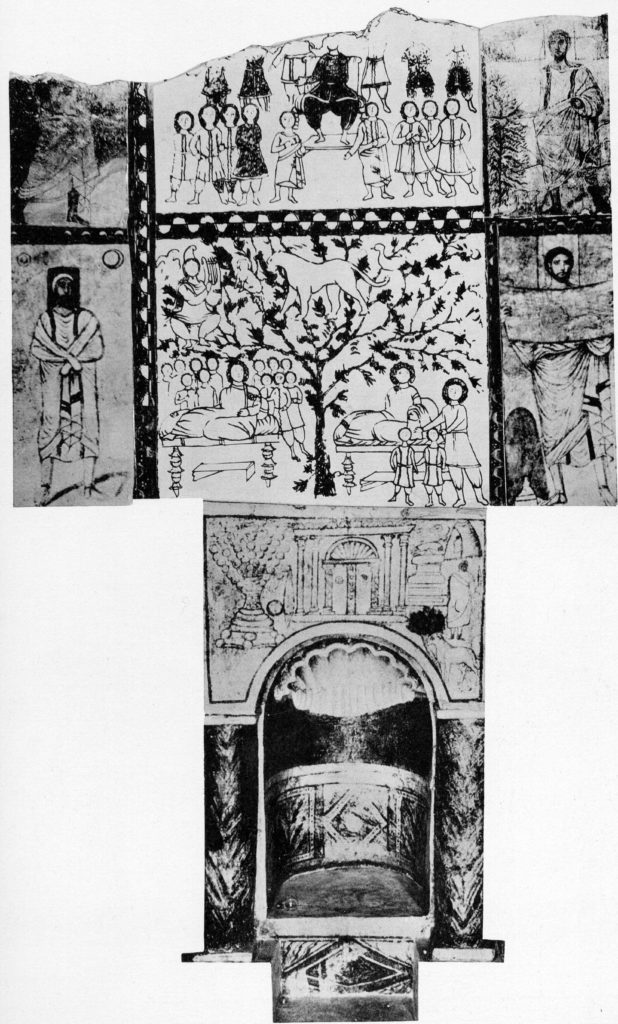
Figure 11. The Dura Europos Torah Shrine topped with a tree of life mural that is surrounded by four portraits of Moses
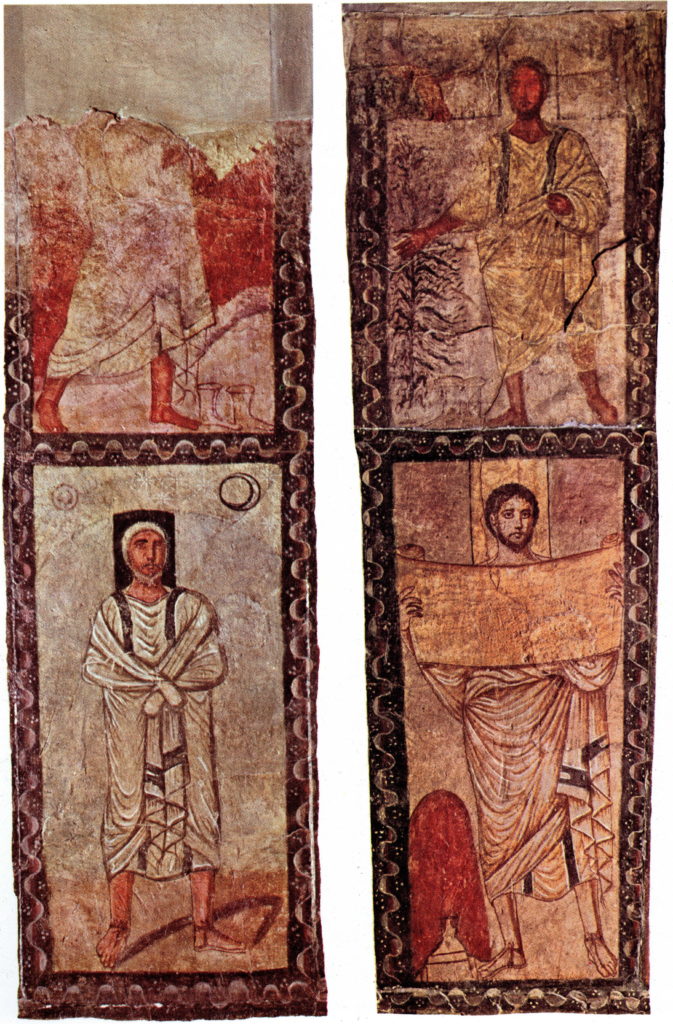
Figure 12. The Four Portraits of Moses
The focal point of the synagogue’s art is the Torah Shrine, which is decorated with an elaborate mural containing a “tree of life” that is straightforwardly interpreted as heralding the future exaltation of Israel as a people. In addition, the theme of individual exaltation was seen by Yale scholar Erwin Goodenough as being carried forward in four portraits that surround the “tree of life” panel.[89] Their importance can be inferred from their prominent position and the fact that they are the only individual portraits to be found anywhere in the synagogue.
Goodenough identified Moses as the subject of each of the four portraits,[90] as he is shown in what seem to be the progressive sacred experiences of (1) the burning bush, (2) the receipt of the Tablets of the Law, and (3) the reading of the Law[91]—”exactly the incidents most stressed in the mystic account of Moses by Philo.”[92] The final portrait (4) shows a figure standing on the earth with the sun, moon, and seven stars (i.e., planets) above his head.
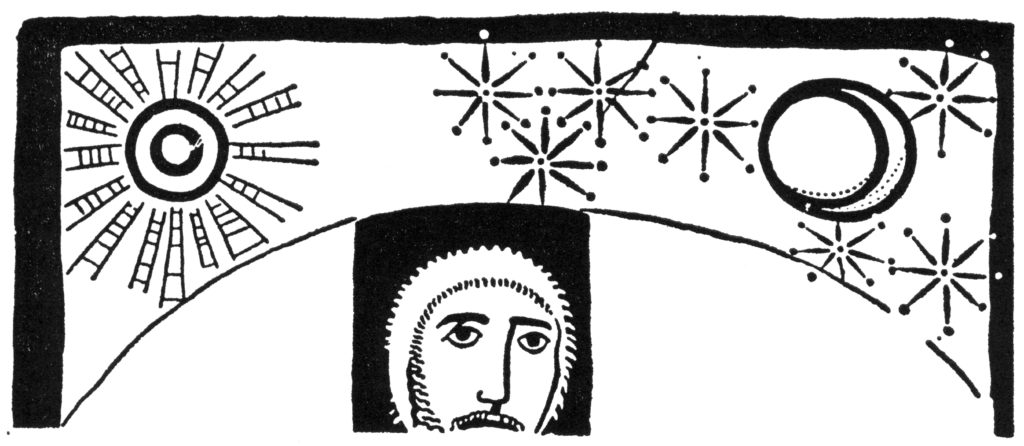
Figure 13. Sketch of Sun, Moon, and Stars Surrounding the Final Portrait of Moses
Goodenough took special note of the striking representation of the sun with its depiction of laddered rays, recalling the ubiquitous symbolism of the “divine ladder that connects man to God.”[93] He concluded that the subject of the mural is again Moses, “now in his old age, and ascending to heaven.”[94]
In the context of Goodenough’s interpretation, the fourth portrait of Moses in the Dura synagogue constitutes not only a witness to his own exaltation, but also an implicit invitation to all those in the congregation to follow him. In his discussion of late Second Temple Jewish mysticism, Goodenough summarized Philo’s descriptions of “two successive initiations within a single Mystery,” constituting “a ‘Lesser’ Mystery in contrast with a ‘Greater,'” as follows:[95]
For general convenience we may distinguish them as the Mystery of Aaron and the Mystery of Moses [cf. D&C 84:19-23, 31-34 where the ordinances taught by Moses are associated with the greater (i.e., Melchizedek) priesthood[96]]. The Mystery of Aaron got its symbolism from the great Jerusalem cultus. … The Mystery of Moses … led the worshipper above all material association; he died to the flesh, and in becoming reclothed in a spiritual body moved progressively upwards … and at last ideally to God himself. … The objective symbolism of the Higher Mystery was the holy of holies with the ark, a level of spiritual experience which was no normal part of even the high-priesthood. Only once a year could the high priest enter there, and then only … when so blinded by incense that he could see nothing of the sacred objects within. The Mystery of Aaron was restricted to the symbolism of the Aaronic high priest. … In a striking passage Philo contrasts this type of priest with Moses, who … became the true initiate …, hierophant of the rites …, and teacher of divine things.
Philo taught that the experience of Moses was not meant to be unique; rather, he exemplified a pattern that previously had been followed by Abraham and would continue afterward for all who belonged to true Israel.[97] In his role as “teacher of divine rites,” wrote Philo, “[Moses] will impart to those whose ears are purified. He [the one who receives these rites] then has ever the divine spirit at his side, taking the lead in every journey of righteousness”[98] or, in the translation of Goodenough, “to lead one along the ‘whole road,’ the entire way to perfection.”[99]
More detailed discussion of the artwork of Dura Europos and its implications for the theme of ritual exaltation can be found elsewhere.[100]
Further Study
To access Gary Rendsburg’s 2013 video presentation of “Moses the Magician” at the UCSD Exodus Conference “Out of Egypt: Israel’s Exodus Between Text and Memory, History and Imagination,” see https://www.youtube.com/watch?v=aYhNo1jC9Fg.
For Rendsburg’s 8 March 2007 BYU Kennedy Center talk entitled “Light from Egypt on the Exodus Story,” see https://www.youtube.com/watch?v=_iwvTZnwSy0.
For more on how the story of Moses in Exodus touches on themes pertinent to Egyptian tradiion and religion, see the relevant publications of Noegel (S. B. Noegel, Moses and Magic; S. B. Noegel, Egyptian “Magicians”) and Rendsburg (G. A. Rendsburg, Egyptian Sun-God Ra; G. A. Rendsburg, Moses as Equal; G. A. Rendsburg, Moses the Magician; G. A. Rendsburg, Reading the Plagues).
For a Book of Mormon Central KnoWhys related to this section of Exodus, see https://knowhy.bookofmormoncentral.org/lesson/old-testament/lesson-13-bondage-passover-and-exodus
For a more extensive discussion of Jewish traditions of Moses as a god and king, see J. M. Bradshaw, Ezekiel Mural; W. A. Meeks, Moses, pp. 17-21.
For a discussion of Moses “song” and “ladder” of heavenly ascent in the context of temple ordinances, see J. M. Bradshaw, Faith, Hope, and Charity, pp. 44-46.
For other scripture resources relating to this lesson, see The Interpreter Foundation Old Testament Gospel Doctrine Index (https://dev.interpreterfoundation.org/gospel-doctrine-resource-index/ot-gospel-doctrine-resource-index/) and the Book of Mormon Central Old Testament KnoWhy list (https://knowhy.bookofmormoncentral.org/tags/old-testament).
References
Barker, Margaret. The Hidden Tradition of the Kingdom of God. London, England: Society for Promoting Christian Knowledge (SPCK), 2007.
Bradley, Don. “Piercing the veil: Temple worship in the lost 116 pages.” Presented at the 2012 FAIR Conference, Salt Lake City, UT, August 2-3, 2012. http://www.fairlds.org/fair-conferences/2012-fair-conference/2012-piercing-the-veil-temple-worship-in-the-lost-116-pages. (accessed September 3, 2012).
———. “Personal Conversation.” August 21, 2014.
Bradshaw, Jeffrey M. “The Ezekiel Mural at Dura Europos: A tangible witness of Philo’s Jewish mysteries?” BYU Studies 49, no. 1 (2010): 4-49.
Bradshaw, Jeffrey M., and Ronan J. Head. “The investiture panel at Mari and rituals of divine kingship in the ancient Near East.” Studies in the Bible and Antiquity 4 (2012): 1-42.
Bradshaw, Jeffrey M. Temple Themes in the Book of Moses. 2014 update ed. Salt Lake City, UT: Eborn Publishing, 2014.
———. Temple Themes in the Oath and Covenant of the Priesthood. 2014 update ed. Salt Lake City, UT: Eborn Books, 2014.
———. “‘There’s the boy I can trust’: Dennison Lott Harris’ first-person account of the conspiracy of Nauvoo and and events surrounding Joseph Smith’s “Last Charge” to the Twelve Apostles.” Interpreter: A Journal of Mormon Scripture 21 (2016): 23-118.
———. “What did Joseph Smith know about modern temple ordinances by 1836?”.” In The Temple: Ancient and Restored. Proceedings of the 2014 Temple on Mount Zion Symposium, edited by Stephen D. Ricks and Donald W. Parry. Temple on Mount Zion 3, 1-144. Orem and Salt Lake City, UT: The Interpreter Foundation and Eborn Books, 2016.
———. “Faith, hope, and charity: The ‘three principal rounds’ of the ladder of heavenly ascent.” In “To Seek the Law of the Lord”: Essays in Honor of John W. Welch, edited by Paul Y. Hoskisson and Daniel C. Peterson, 59-112. Orem, UT: The Interpreter Foundation, 2017.
Bradshaw, Jeffrey M., and Matthew L. Bowen. “”By the Blood Ye Are Sanctified”: The Symbolic, Salvific, Interrelated, Additive, Retrospective, and Anticipatory Nature of the Ordinances of Spiritual Rebirth in John 3 and Moses 6.” Interpreter: A Journal of Mormon Scripture 24 (2017): 123-316. https://journal.interpreterfoundation.org/by-the-blood-ye-are-sanctified-the-symbolic-salvific-interrelated-additive-retrospective-and-anticipatory-nature-of-the-ordinances-of-spiritual-rebirth-in-john-3-and-moses-6/. (accessed January 10, 2018).
Eaton, John H. The Psalms: A Historical and Spiritual Commentary with an Introduction and New Translation. London, England: T&T Clark, 2003.
Esplin, Ronald K. “Understanding the Council of Fifty and its minutes.” BYU Studies 55, no. 3 (2016): 7-22.
Fine, Steven. 2005. “Liturgy and the art of the Dura Europos synagogue.” In Art and Judaism in the Greco-Roman World: Toward a New Jewish Archaeology, edited by Steven Fine, 172-83. Cambridge, England: Cambridge University Press, 2007.
Fletcher-Louis, Crispin H. T. “Religious experience and the apocalypses.” In Inquiry into Religious Experience in Early Judaism and Early Christianity, edited by Frances Flannery, Colleen Shantz and Rodney A. Werline, 125-46. Atlanta, GA: Society of Biblical Literature, 2008.
Foster, Benjamin R. Before the Muses: An Anthology of Akkadian Literature. Third ed. Bethesda, MD: CDL Press, 2005.
Goldstein, Jonathan A. “The Judaism of the synagogues (focusing on the synagogue of Dura-Europos).” In Judaism in Late Antiquity:, edited by Jacob Neusner. 3 vols. Vol. 2: Historical Syntheses. Leiden, The Netherlands: Brill, 1995.
Goodenough, Erwin Ramsdell. By Light, Light: The Mystic Gospel of Hellenistic Judaism. New Haven, CT: Yale University Press, 1935.
———. Symbolism in the Dura Synagogue. 3 vols. Jewish Symbols in the Greco-Roman Period 9-11, Bollingen Series 37. New York City, NY: Pantheon Books, 1964.
———. 1940. An Introduction to Philo Judaeus. 2nd Revised ed. Oxford, England: Basil Blackwell, 1962.
Hallo, William W., and K. Lawson Younger, eds. The Context of Scripture. 3 vols. Leiden, The Netherlands: Brill Academic Publishers, 1996-2002.
Hayward, C. T. R. Interpretations of the Name Israel in Ancient Judaism and Some Early Christian Writings: From Victorious Athlete to Heavenly Champion. Oxford, England: Oxford University Press, 2005.
Hoffmeier, James K. Israel in Egypt: The Evidence for the Authenticity of the Exodus Tradition. Oxford, England: Oxford University Press, 1996.
Holbrook, Brett L. “The sword of Laban as a symbol of divine authority and kingship.” Journal of Book of Mormon Studies 2, no. 1 (1993): 39-72. https://scholarsarchive.byu.edu/jbms/vol2/iss1/4/. (accessed October 25).
Hort, Greta. “The Plagues of Egypt 1.” Zeitschrift für die alttestamentliche Wissenschaft 69 (1957): 84-103.
———. “The Plagues of Egypt 2.” Zeitschrift für die alttestamentliche Wissenschaft 70 (1958): 48-59.
Kimball, Spencer W. “The false gods we worship.” Ensign 6, June 1976, 3-6.
Lichtheim, Miriam, ed. 1973-1980. Ancient Egyptian Literature: A Book of Readings. 3 vols. Berkeley, CA: The University of California Press, 2006.
Lowenstamm, Samuel E. The Evolution of the Exodus Tradition. Translated by B. Schwartz. Jerusalem: Magnes Press, 1992.
Meeks, Wayne A. “Moses as God and King.” In Religions in Antiquity: Essays in Memory of Erwin Ramsdell Goodenough, edited by Jacob Neusner. Religions in Antiquity, Studies in the History of Religions (Supplements to Numen) 14, 354-71. Leiden, The Netherlands: Brill, 1968.
Nibley, Hugh W., and Michael D. Rhodes. One Eternal Round. The Collected Works of Hugh Nibley 19. Salt Lake City, UT: Deseret Book, 2010.
Nibley, Hugh W. 1975. The Message of the Joseph Smith Papyri: An Egyptian Endowment. 2nd ed. Salt Lake City, UT: Deseret Book, 2005.
Noegel, Scott B. “Moses and magic: Notes on the book of Exodus.” Journal of the Ancient Near Eastern Society 24 (1996): 45-59. https://pdfs.semanticscholar.org/dee0/913828e224942b51f4c6863344375b82ecc2.pdf. (accessed March 21, 2018).
———. 2017. The Egyptian “magicians” (30 March 2017). In. https://thetorah.com/the-egyptian-magicians/. (accessed March 19, 2018).
Philo. b. 20 BCE. “On the Giants (De Gigantibus).” In Philo, edited by F. H. Colson and G. H. Whitaker. 12 vols. Vol. 2. Translated by F. H. Colson and G. H. Whitaker. The Loeb Classical Library 227, ed. Jeffrey Henderson, 441-79. Cambridge, MA: Harvard University Press, 1929.
Plutarch. 1936. Isis and Osiris (as translated and published in Loeb Classical Library Edition). In Penelope, University of Chicago. http://penelope.uchicago.edu/Thayer/e/roman/texts/plutarch/moralia/isis_and_osiris*/a.html. (accessed March 21, 2018).
Postgate, J. N. Early Mesopotamia: Society and Economy at the Dawn of History. London, England: Routledge, 1992.
Redford, Donald B. “The literary motif of the exposed child.” Numen 14 (1967): 209-28.
Rendsburg, Gary A. “The Egyptian Sun-God Ra in the Pentateuch.” Henoch 10 (1988): 3-15.
———. “Moses as equal to Pharaoh.” In Text, Artifact, and Image: Reveling Ancient Israelite Religion, edited by Gary A Beckman and Theodore J. Lewis. Brown Judaic Studies 346, 201-19. Providence, RI: Brown Judaic Studies, 2006. http://jewishstudies.rutgers.edu/faculty/core-faculty-information/gary-a-rendsburg/132-publications-of-gary-a-rendsburg. (accessed March 19, 2018).
———. “Moses the magician.” In Israel’s Exodus in Transdisciplinary Perspective: Text, Archaeology, Culture, and Geosciance, edited by Thomas E. Levy, Thomas Schneiger and William H. C. Propp. Quantitative Methods in the Humanities and Social Sciences, 243-58. Berlin, Germany: Springer, 2015. http://jewishstudies.rutgers.edu/faculty/core-faculty-information/gary-a-rendsburg/132-publications-of-gary-a-rendsburg. (accessed March 19, 2018).
———. 2015. Reading the plagues in their ancient Egyptian context (10 January 2015). In The Torah.com: A Historical and Contextual Approach. http://thetorah.com/plagues-in-their-ancient-egyptian-context/. (accessed January 28, 2018).
Rolph, Daniel N. “Prophets, kings, and swords: The sword of Laban and its possible pre-Laban origin.” Journal of Book of Mormon Studies 2, no. 1 (1993): 73-79. https://scholarsarchive.byu.edu/jbms/vol2/iss1/5/. (accessed October 25).
Simpson, William Kelly, ed. The Literature of Ancient Egypt. New Haven, CT: Yale University Press, 2003.
Smith, Joseph, Jr. The Words of Joseph Smith. Salt Lake City, UT: Bookcraft, 1980. https://rsc.byu.edu/archived/words-joseph-smith-contemporary-accounts-nauvoo-discourses-prophet-joseph/1843/21-may-1843. (accessed February 6, 2016).
Smith, Joseph, Jr., Matthew J. Grow, Ronald K. Esplin, Mark Ashhurst-McGee, Jeffrey D. Mahas, and Gerrit Dirkmaat. Council of Fifty, Minutes, March 1844-January 1846. The Joseph Smith Papers, Administrative Records 1, ed. Ronald K. Esplin and Matthew J. Grow. Salt Lake City, UT: The Church Historian’s Press, 2016.
Smith, R. Eric, and Matthew J. Grow. Council of Fifty in Nauvoo, Illinois. In Church History: Perspectives on Church History. https://history.churchofjesuschrist.org/article/council-of-fifty-minutes-joseph-smith-papers?lang=eng (accessed July 25, 2017).
Tvedtnes, John A. “Rod and sword as the word of God.” Journal of Book of Mormon Studies 5, no. 2 (1996): 148-55. https://scholarsarchive.byu.edu/jbms/vol5/iss2/6/. (accessed October 25).
———. “”The workmanship thereof was exceedingly fine”.” Journal of Book of Mormon Studies 6, no. 1 (1997): 73-75. https://scholarsarchive.byu.edu/jbms/vol6/iss1/8/. (accessed October 25).
Vandier, Jacques. Le Papyrus Jumilhac. Paris, France: Centre National de la Recherche Scientifique, 1962.
Walton, John H. Ancient Near Eastern Thought and the Old Testament: Introducing the Conceptual World of the Hebrew Bible. Grand Rapids, MI: Baker Academic, 2006.
Weitzmann, Kurt, and Herbert Kessler. The frescoes of the Dura Synagogue and Christian Art. Dumbarton Oaks Research Library and Collection 28. Washington, DC: Dumbarton Oaks Research Library and Collection, 1990.
Welch, John W. The Sermon at the Temple and the Sermon on the Mount. Salt Lake City, UT: Deseret Book, 1990. https://scholarsarchive.byu.edu/mi/89/. (accessed December 19, 2016).
———. “Counting to ten.” Journal of Book of Mormon Studies 12, no. 2 (2003): 42-57, 113-14. http://publications.mi.byu.edu/publications/jbms/12/2/S00006-50be698e8c0ab5Welch.pdf. (accessed January 15, 2016).
———. The Sermon on the Mount in the Light of the Temple. Farnham, England: Ashgate, 2009.
Wells, Bruce. “Exodus.” In Genesis, Exodus, Leviticus, Numbers, Deuteronomy, edited by John H. Walton. Zondervan Illustrated Bible Backgrounds Commentary 1. Grand Rapids, MI: Zondervan, 2009.
Wheeler, Brannon M. Mecca and Eden: Ritual, Relics, and Territory in Islam. Chicago, IL: University of Chicago Press, 2006.
Widengren, Geo. The King and the Tree of Life in Ancient Near Eastern Religion. King and Saviour IV, ed. Geo Widengren. Uppsala, Sweden: Almquist and Wiksells, 1951.
Wyatt, Nicolas. “Arms and the king: The earliest allusions to the Chaoskampf motif and their implications for the interpretation of the Ugaritic and biblical traditions.” In ‘There’s Such Divinity Doth Hedge a King’: Selected Essays of Nicolas Wyatt on Royal Ideology in Ugaritic and Old Testament Literature, edited by Nicolas Wyatt. Society for Old Testament Study Monographs, ed. Margaret Barker, 151-89. Aldershot, England: Ashgate, 2005.
———. “Degrees of divinity: Some mythical and ritual aspects of West Semitic kingship.” In ‘There’s Such Divinity Doth Hedge a King’: Selected Essays of Nicolas Wyatt on Royal Ideology in Ugaritic and Old Testament Literature, edited by Nicolas Wyatt. Society for Old Testament Study Monographs, ed. Margaret Barker, 191-220. Aldershot, England: Ashgate, 2005.
Endnotes
56 They are they who are priests and kings, who have received of his fulness, and of his glory;
57 And are priests of the Most High, after the order of Melchizedek, which was after the order of Enoch, which was after the order of the Only Begotten Son.
58 Wherefore, as it is written, they are gods, even the sons of God—
Anciently, the sword (or some equivalent of the royal arms (see, e.g., N. Wyatt, Arms)) and staff were interchangeable symbols (B. M. Wheeler, Mecca, p. 43) — the former to be used in defense in times of war and the latter to be used as an instrument of measurement in the building of temples, palaces — and worlds — in times of peace (J. M. Bradshaw et al., Investiture Panel, pp. 31-39). Compare the dichotomy of the city of peace and the city of war on the shield of Achilles, given him in heaven, as described in Homer’s Iliad (see H. W. Nibley et al., One Eternal Round, p. 396; see also pp. 395-400).
A biblical parallel to the dichotomy between the commission to build and the commission to wage war can be found in the story of King David, who was forbidden by God from constructing a temple because of his career as a fighter. Instead, David’s son Solomon, a “man of rest,” was eventually given the commission to build the earthly House of God. Speaking to David, the Lord said (1 Chronicles 22:8-9):
8 … Thou hast shed blood abundantly, and hast made great wars: thou shalt not build an house unto my name…
9 Behold, a son shall be born to thee, who shall be a man of rest; and I will give him rest from all his enemies round about: for his name shall be Solomon, and I will give peace and quietness unto Israel in his days.
For more on the sword of Laban, see J. A. Tvedtnes, Workmanship; D. N. Rolph, Prophets; J. A. Tvedtnes, Rod and Sword; B. L. Holbrook, Sword of Laban.
A ruler’s claim to divinity can be expressed in three ways: his name may be preceded by the cuneiform sign for god, in the same way as other deities’ names are, his headdress may be represented with horns, the mark of a god in the iconography, and in a variety of ways evidence may be seen that he was worshipped by the population in a cult of his own.… Another, attractive, hypothesis is that any rulers who were offspring of a sacred marriage could legitimately claim both divine and royal parentage. Gudea, for instance, says that he had no mother and no father and was the son of the goddess of Lagas, Garumdug; however, elsewhere he also states that he is the son of Ninsun, of Bau and of Nanse, which makes it hard to be sure of the implications of such statements. He, however, did not lay claim to divinity.
The seeming contradiction in Gudea’s claimed parentage might be explained by analogy to JST Hebrews 7:3 (“which order was without father, without mother, without descent, having neither beginning of days, nor end of life”), where the parallel sense is that although Melchizedek certainly had been born to earthly parents, he later had been reborn as a “Son of God” through priesthood ordinances (see J. M. Bradshaw, Temple Themes in the Oath, pp. 53-54, 60-62, 169-170 nn. 313-314).
[94]. Ibid., 9:101, 116–18.


